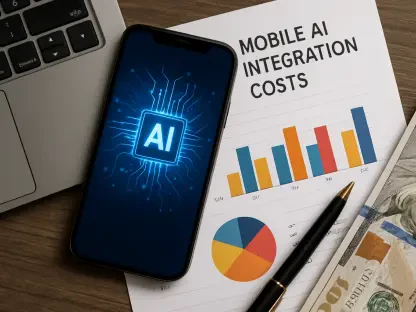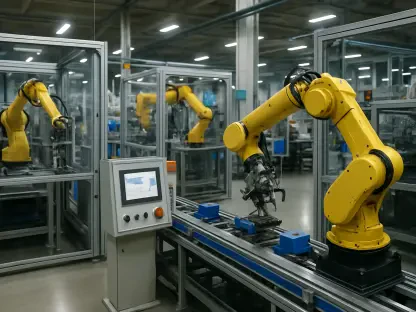In the dynamic world of web development, staying updated with the latest trends is crucial for businesses aiming to thrive in the digital landscape. As technological capabilities and user expectations rapidly evolve, so too must web development practices. By 2025, several key trends are expected to significantly shape the industry. Let’s dive into the most impactful trends and innovations to watch for.
The Growing Importance of Contemporary Web Development
Maintaining a robust online presence is more critical now than ever. The digital-first approach is becoming the norm, with businesses striving to meet sophisticated user demands. With a significant rise in website design sales, it’s evident that companies must continually update their web practices to capture and retain consumer attention. The market is forecasted to hit a valuation of $56.82 billion in 2024, illustrating the necessity of embracing these advancements.
As consumers increasingly turn to the internet for shopping, services, and entertainment, businesses face the pressing need to enhance their digital footprints. Outdated or poorly optimized websites risk losing potential customers to more digitally savvy competitors. This shift underscores not just the importance but the urgency of adopting contemporary web development practices. Companies must be vigilant in integrating the latest design elements and technologies to stay relevant and engaging in a rapidly evolving digital marketplace.
Customized Visuals: Making Your Website Stand Out
As the digital marketplace becomes increasingly crowded, the importance of unique web design cannot be overstated. Investing in customized visuals such as unique layouts, images, and graphics can set a business apart from its competitors. These custom elements not only enhance brand identity but also improve user navigation and engagement. In an era where users are bombarded with online content, standing out is pivotal to becoming memorable and accessible.
Customized visuals convey a company’s identity in ways that generic templates cannot. By reflecting the brand’s personality and values through distinct visuals, businesses can create an emotional connection with their audience. These connections are key to fostering loyalty and repeat patronage. Furthermore, unique visuals can make a site more intuitive to navigate, offering a better user experience that translates into longer visit durations and lower bounce rates. As user attention spans wane, capturing interest quickly and maintaining it through engaging visuals becomes a decisive factor in a website’s effectiveness.
Mobile-First Design: Prioritizing Mobile Users
The shift to mobile-first design is no longer optional—it’s imperative. With over half of global web traffic now coming from mobile devices, websites must be optimized for smaller screens. This involves designing content primarily with mobile users in mind and then scaling it up for larger screens. The result is a more intuitive and accessible user experience that caters to a broader audience, enhancing engagement and retention rates.
The mobile-first approach ensures that websites are user-friendly across all devices, from smartphones and tablets to desktops. This design philosophy prioritizes minimalism and functionality, helping users find information quickly and easily on smaller screens. Mobile optimization not only caters to the growing number of mobile users but also influences search engine rankings, as major search engines like Google prioritize mobile-friendly sites in their algorithms. Businesses that fail to adapt to mobile-first design risk losing visibility and competitiveness in search results, underscoring the critical importance of this trend.
Dark Mode: Enhancing Aesthetics and Usability
Dark mode is gaining traction for its dual benefits of aesthetics and functionality. It provides an alternative to traditional light backgrounds, offering reduced eye strain and conserving battery life on OLED screens. By 2025, incorporating a dark mode option will likely become standard practice, catering to user preferences and enhancing the overall digital experience. This modern, sleek design not only improves usability but also keeps users engaged.
By reducing the harshness of bright screens, dark mode offers a more comfortable viewing experience, especially in low-light environments. Users increasingly prefer the option to toggle between light and dark modes based on their needs and conditions. For developers, implementing dark mode ensures that their sites offer flexibility and cater to evolving user preferences. This trend highlights the importance of user-centric design in web development, where the priority is enhancing the user experience through adaptable, responsive features.
Immersive Experiences with AR/VR
Augmented Reality (AR) and Virtual Reality (VR) are set to revolutionize web interactions. By enabling immersive, interactive experiences, these technologies can significantly boost user engagement. Industries such as retail, real estate, eCommerce, and tourism are beginning to harness AR/VR to provide virtual try-ons, 3D product views, and lifelike tours. These features, accessible directly through web browsers, offer enhanced user experiences and more meaningful connections with digital content.
AR/VR technologies create opportunities for consumers to engage with products and services in unprecedented ways, inviting them into virtual environments that closely mimic real-world experiences. This immersive interaction can lead to higher conversion rates as customers feel more confident in their purchase decisions after interacting with a product virtually. These technologies are also powerful storytellers, enabling brands to craft compelling narratives that deeply resonate with users. As AR/VR continues to evolve, the potential for creating highly engaging and interactive web experiences will only grow, making these technologies essential tools in modern web development.
Single Page Applications (SPAs): Smoother User Experiences
Single Page Applications are becoming increasingly popular due to their ability to provide fast load times and seamless browsing experiences. Unlike traditional websites that reload entire pages, SPAs dynamically update content as users interact, making the user experience smoother and faster. This efficiency is crucial for retaining visitors in an age where quick access to information is paramount.
SPAs’ streamlined performance is achieved by loading the entire site framework initially and then using JavaScript to fetch new content dynamically. This approach eliminates the wait times associated with full-page reloads, creating a more fluid user experience. By minimizing interruptions, SPAs keep users engaged and reduce the likelihood of them navigating away from the site. Moreover, SPAs are particularly well-suited for complex applications, such as social media platforms and project management tools, where real-time data updates and seamless navigation are critical components of the user experience.
Integrating Emerging Technologies: AI, ML, and Blockchain
Emerging technologies like Artificial Intelligence (AI), Machine Learning (ML), and Blockchain are poised to transform web development. AI and ML can create smarter, more personalized user experiences, such as AI-driven chatbots offering real-time support. Blockchain, on the other hand, promises enhanced security, transparency, and trust, addressing modern concerns about privacy and data management. These technologies are set to make web interactions more efficient and secure.
AI and ML enable websites to adapt and respond to user behavior, providing tailored content and recommendations that enhance user engagement and satisfaction. These technologies can automate and optimize various web functions, from customer support to content management, creating more efficient and responsive sites. Blockchain, renowned for its security features, can safeguard data transactions and enhance trustworthiness, making it particularly valuable for eCommerce and financial services. Integrating these emerging technologies will not only improve user experiences but also fortify web operations against evolving cyber threats.
The Rise of Progressive Web Apps (PWAs)
Progressive Web Apps are gaining traction for their ability to offer app-like experiences directly through web browsers. PWAs combine the best features of web and mobile apps, including offline capabilities, fast load times, and seamless performance across devices. Their convenience and efficiency make them particularly valuable in industries like eCommerce and news, where user engagement is crucial.
PWAs are designed to work reliably even in challenging network conditions, ensuring users can access content anytime, anywhere. By using modern web technologies, PWAs provide a high-quality user experience on par with native mobile apps without requiring downloads from app stores. They offer features like push notifications and offline access, which enhance usability and keep users engaged. The ability to update instantly without requiring user intervention further adds to their appeal, making them a powerful tool for maintaining user interest and retention.
Enhanced Security Measures
With the ever-increasing threat of cyberattacks, enhancing web security is a top priority. Stronger security protocols, such as multi-factor authentication, encryption, and secure frameworks, are essential to protecting sensitive data and ensuring user privacy. SSL certificates have become a baseline requirement, with additional measures necessary to stay ahead of evolving threats and fortify trust.
In this digital age, users are more aware of security risks and demand assurances that their data is safe. Implementing advanced security measures not only protects against breaches but also builds trust with users, fostering loyalty and encouraging repeat visits. Prioritizing security in web development helps safeguard company reputation and integrity. As cyber threats become more sophisticated, continuous investment in the latest security technologies is imperative to maintaining user confidence and complying with regulatory requirements.
Micro Interactions: Refining User Engagement
Micro interactions—subtle design elements like animations and hover effects—are set to become more sophisticated by 2025. These small feedback indicators guide users through a site, enhancing engagement by offering smooth transitions and dynamic feedback. By integrating micro interactions, businesses can improve the user journey, making the interface feel more responsive and interactive.
Micro interactions create a layer of intuitive interactivity that guides user behavior without overwhelming them with information. These elements provide instant feedback, making the interface feel alive and responsive, which subconsciously encourages users to explore further. When designed thoughtfully, micro interactions can indicate actions, highlight important information, and signal success or errors, thereby improving the overall user experience. They play a crucial role in keeping users engaged and satisfied by making interactions with the site more dynamic and enjoyable.
Voice Search Optimization: Preparing for the Future
As voice assistants like Siri, Alexa, and Google Assistant become more prevalent, optimizing websites for voice search is critical. By 2025, adopting voice search-friendly SEO practices will be necessary to maintain visibility in search engine rankings. This involves focusing on natural language processing, ensuring that content is easily accessible.
Voice search optimization reflects the growing trend of users seeking faster, hands-free ways to access information. By structuring content to align with natural speech patterns, businesses can capture the increasing number of voice search queries. This involves incorporating conversational keywords, optimizing for local search, and ensuring that content is concise and direct. As voice technology advances, the way users interact with the digital world will continue to evolve, making it essential for businesses to adapt their SEO strategies to remain competitive.
Conclusion
In the ever-evolving field of web development, keeping up with the latest trends is essential for businesses looking to succeed in the digital marketplace. As technology advances and user expectations increase, web development methodologies must adapt accordingly. By 2025, several major trends and innovations are anticipated to make a significant impact on the industry.
One area to watch is the growing importance of artificial intelligence and machine learning integration. These technologies are set to revolutionize how websites interact with users, offering more personalized and intuitive experiences. Augmented Reality (AR) and Virtual Reality (VR) functionalities are also becoming more prevalent, providing immersive experiences that can deeply engage users in new ways.
Moreover, Progressive Web Apps (PWAs) are gaining traction as they combine the benefits of both web and mobile applications, delivering faster load times and offline capabilities. Enhanced cybersecurity measures will become increasingly critical to protect sensitive data and build user trust. Also, the continued rise of voice search optimization means websites will need to adapt their content to be more voice-search friendly.
Finally, the movement toward more sustainable and eco-friendly web development practices is expected to grow. Businesses are likely to focus on creating energy-efficient websites to reduce their carbon footprint.
Staying ahead of these trends will be vital for businesses to maintain their competitive edge and meet the ever-growing demands of users in the digital age.









